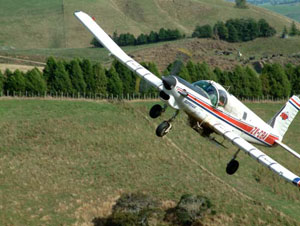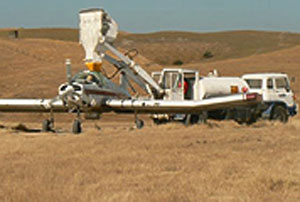Agricultural Pilot
Tasks & duties

Agricultural pilots may do some or all of the following:
-
consult with customers about the chemicals or fertiliser to be used
-
inspect the area to be sprayed
-
calculate the amount and cost of chemicals or fertiliser required
-
calculate the rate at which the chemicals or fertilisers will be applied, and the best method of application
-
consult with customers about the airstrip or landing pad that will be used
-
check that the customer has warned any parties that may be affected by the spraying
-
co-ordinate work schedules with the ground support staff
-
study weather forecasts
-
check the load, fuel and equipment on board the aeroplane or helicopter and other vehicles such as the trucks that carry the chemicals or fertiliser
-
refuel and perform safety checks on the aeroplane or helicopter prior to departure
-
fly the aeroplane or helicopter
-
apply chemicals or fertiliser to the farm land
-
communicate with the ground support staff
-
keep a record of flight times and the chemicals or fertiliser that has been used
-
ensure the aeroplane or helicopter is maintained
-
liaise with aircraft maintenance engineers who complete any aircraft repairs
Specialisations
Some agricultural pilots operate fixed-wing aircraft and others fly helicopters.
Skills & knowledge

Agricultural pilots need to have:
-
excellent flying skills
-
knowledge of flight theory and flight planning
-
skill in interpreting flight plans and navigation data
-
knowledge of different types of farming, and the chemicals and fertilisers farmers use
-
an understanding of the Hazardous Substances and New Organisms (HSNO) Act and the Resource Management Act
-
understanding of civil aviation laws
-
communication skills
-
planning and decision-making skills
-
record-keeping skills
-
knowledge of safety rules and emergency procedures
-
an understanding of how weather can affect flight.
Agricultural pilots must also be able to comply with air and water quality plans and industry codes of practice.
Entry requirements
The first step to becoming an agricultural pilot is to get your Commercial Pilot Licence (CPL).
After receiving your CPL, you need to obtain an agricultural rating (a type of qualification) through ground and flight training. It takes a minimum of 85 hours to complete this training, but may take 100 hours or more to show competence.
You will also need to complete a pilot chemical rating.
Civil Aviation Authority of New Zealand website – agricultural ratings (PDF – 52.5KB)
Civil Aviation Authority of New Zealand website – pilot chemical rating (PDF – 35.1KB)
Civil Aviation Authority of New Zealand website – how to be a pilot guide (PDF – 0.99MB)
Secondary education
There are no specific secondary educational requirements to become an agricultural pilot. However, Sixth Form Certificate or NCEA equivalent English, maths, computing and physics are helpful.
Tertiary education
Private and commercial pilot licence training is available at tertiary education institutions, aero clubs, flight training schools, the Royal NZ Air Force and the Royal NZ Navy.
Aviation Careers website – flight training organisations in New Zealand
Royal NZ Navy website – information about helicopter pilot training
Royal NZ Air Force website – information about pilot training
Training on the job
To become an agricultural pilot, you usually need to start working for a company as a loader/driver where you help with the storage and transport of fertilisers and chemicals.
When the company is confident in your abilities, they will either train you as an agricultural pilot, or in some situations new pilots may pay to be trained.
Useful experience
Any farm work or experience working with heavy machinery is useful, as are skills in an engineering or mechanical trade. Work as a loader/driver is an excellent background for people wanting to become agricultural pilots.
Related courses
Aircraft Operation
For more information, please refer to Career Services.
Document Actions
